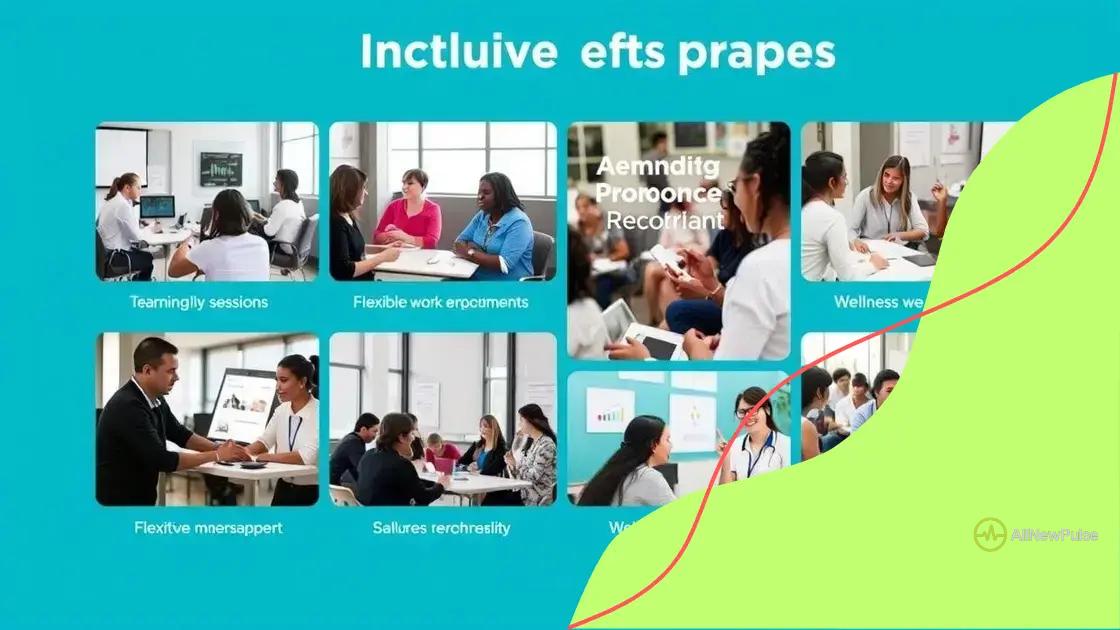Designing inclusive and equitable benefit programs

Designing inclusive and equitable benefit programs involves engaging employees in the process, gathering regular feedback, and adapting benefits to meet diverse needs, ultimately fostering a supportive and collaborative workplace culture.
Designing inclusive and equitable benefit programs is crucial for fostering diversity and belonging in today’s workplaces. Have you considered how your current offerings impact all employees? Let’s dive into this important topic.
Understanding the importance of inclusion in benefits
Understanding the importance of inclusion in benefits is essential for any organization striving for a supportive workplace. When employees feel noticed and valued, they perform better and are more committed to their jobs.
A truly inclusive benefits program recognizes and accommodates the diverse needs of employees. It allows every individual to utilize the benefits available to them, regardless of their background, role, or personal circumstances. This approach not only boosts employee satisfaction but also enhances overall organizational culture.
Key Components of Inclusive Benefits
To foster a sense of belonging through benefits, organizations should consider the following components:
- Diversity of offerings: Providing various benefit options that cater to different employee needs, such as parental leave, mental health resources, and flexible working hours.
- Accessibility: Ensuring that all employees can easily access and understand their benefits.
- Feedback mechanisms: Actively seeking employee feedback to adapt and improve the benefits program as needed.
Furthermore, an inclusive benefits program meets employees where they are, which means regular evaluation is necessary. Adjustments should align with changing employee demographics and expectations. It’s crucial to communicate the available benefits clearly so everyone understands how to utilize them effectively. Using multiple channels to spread awareness can significantly enhance inclusion.
Incorporating inclusivity in benefits can lead to higher retention rates and increased productivity. Employers who actively pursue this goal set themselves apart as leaders in their industries, creating a community where everyone feels they belong and can thrive.
Key elements of equitable benefit programs
When discussing key elements of equitable benefit programs, it’s important to recognize that successful initiatives are thoughtfully designed. By addressing the unique needs of all employees, these programs create a sense of fairness and belonging.
One foundational element is alignment with employee needs. Equitable benefits should reflect the diverse realities of the workforce. Programs that cater to various circumstances, like health care options or family leave, help create an environment where everyone feels valued.
Essential Components of Equitable Benefits
There are several critical components to consider when designing equitable benefit programs:
- Transparency: Clear communication about benefit offerings ensures all employees understand their options and how to access them.
- Flexibility: Allowing employees to customize benefits to fit their lives can lead to higher satisfaction and retention.
- Regular Assessment: Continuously evaluating and adapting benefits based on employee feedback helps meet changing needs.
Incorporating flexibility encourages employees to choose benefits that resonate with them personally. For instance, offering remote work options or wellness programs can greatly enhance overall job satisfaction. The focus should always be on inclusivity.
Moreover, fostering an environment of equity in benefits can lead to improved team dynamics. When employees feel supported and valued, they are more likely to collaborate and contribute positively to the workplace culture.
In conclusion, successful equitable benefit programs are those that listen to employee feedback and adapt to their needs. By focusing on alignment, transparency, and flexibility, organizations can create an atmosphere of fairness.
Examples of successful inclusive benefit programs

There are many examples of successful inclusive benefit programs that showcase how companies can effectively meet the diverse needs of their employees. These programs not only promote fairness but also contribute to a more positive workplace culture.
One notable example is a technology company that offers flexible parental leave. This program allows both parents, regardless of gender, to take time off during and after childbirth, supporting families in the way that best meets their circumstances. This initiative has led to higher employee retention and satisfaction.
Innovative Benefits in Action
Another inspiring case is a healthcare organization that provides mental health support through wellness programs. These programs include access to therapy, mental health days, and workshops that promote mental well-being. Employees appreciate the initiative, and this has resulted in a marked improvement in workplace morale.
- Comprehensive health insurance: Companies are now offering health plans that cater to various medical needs, including mental health services.
- Student loan assistance: Some organizations help employees pay off student loans, easing their financial burden.
- Remote work options: Flexible work arrangements have become common, allowing employees to work in environments that suit them best.
Another practical initiative came from a retail company that introduced a training program for employees from underrepresented backgrounds. This program not only helps in career advancement but also builds a more diverse management team. Offering mentorship alongside training fosters a supportive community.
These examples highlight the significance of designing benefits that reflect the workforce’s needs. Each initiative creates a sense of belonging and supports employees in their personal and professional lives. By learning from successful programs, organizations can tailor their own benefits to create a more inclusive environment.
How to assess and redesign current benefits
To effectively understand how to assess and redesign current benefits, organizations must take a systematic approach. This process can help maximize the impact of benefit programs while ensuring they are aligned with employee needs.
First, it’s essential to gather data on employee satisfaction regarding existing benefits. Conducting surveys or focus groups can provide valuable insights into what employees appreciate and what areas require improvement. Regular feedback helps to gauge the effectiveness of current offerings and determine if they are serving all employees fairly.
Steps for Assessment and Redesign
Once data is collected, the next step is analyzing it to identify trends and gaps. A clear understanding of employee demographics can improve the inclusivity of benefits. Consider these steps:
- Analyze employee demographics: Understanding who your employees are helps tailor benefits to fit their needs.
- Review usage rates: Look at how often employees are using different benefits to see which are popular and which are underutilized.
- Seek continuous feedback: Establish regular channels for employee feedback to stay updated on changing needs.
After evaluating the current benefits, prioritize changes based on the assessment findings. It’s beneficial to involve employees in the redesign process. This collaboration can enhance the relevance of new initiatives and ensure acceptance across the organization.
Engage employees through workshops or brainstorming sessions to discuss potential changes. When everyone participates in the redesign, they feel a sense of ownership, which fosters a more inclusive atmosphere. In addition, testing new benefits on a small scale before a full rollout can help identify potential issues and make necessary adjustments.
Regularly reviewing and redesigning benefits supports ongoing inclusivity and employee satisfaction. In essence, the goal is to adapt to evolving workplace dynamics while effectively addressing the diverse needs of all employees.
Engaging employees in the benefit design process
Engaging employees in the benefit design process is crucial for creating a program that truly meets their needs. When employees are involved, they feel a sense of ownership and are more likely to utilize the benefits offered.
One effective way to engage employees is through surveys and discussions. Gathering feedback allows organizations to understand what employees value most in their benefits. Additionally, holding focus groups can encourage open communication and help generate new ideas.
Strategies for Engagement
Implementing various strategies can enhance employee involvement:
- Workshops: Host workshops where employees can brainstorm and discuss their ideas for benefits. This collaborative approach can lead to innovative solutions that might not have been considered otherwise.
- Feedback sessions: Create regular feedback sessions where employees can voice their opinions about existing benefits and suggest changes.
- Beta testing: Before rolling out new benefits, consider a pilot program. A small group can test the options and provide valuable insights.
Another important aspect of engagement is communication. Regularly updating employees on changes to the benefits program keeps them informed and involved. Use newsletters, emails, and meetings to share upcoming benefits and potential changes.
It’s also beneficial to celebrate successes. Acknowledge contributions from employees who provide feedback or take part in the design process. By recognizing their efforts, companies boost morale and encourage continued involvement.
Overall, engaging employees in the design of their benefits leads to a program that feels personalized and significant. It fosters a culture of collaboration and support, ensuring that the benefits offered truly enhance the employee experience.
FAQ – Frequently Asked Questions about Designing Inclusive Benefit Programs
Why is employee engagement important in benefit design?
Employee engagement ensures that the benefits meet their needs, making them more likely to utilize the programs offered.
How can organizations gather feedback effectively?
Organizations can gather feedback through surveys, focus groups, and regular feedback sessions to understand employee preferences.
What are some strategies for testing new benefits?
Pilot programs can be effective, allowing a small group of employees to test benefits and provide insights before a full rollout.
How do inclusive benefits impact workplace culture?
Inclusive benefits foster a culture of support and collaboration, leading to higher morale and job satisfaction among employees.





